Big7
The Oracle
Here are good ways.
I haven't found the Billy's version but I'll keep looking
I haven't found the Billy's version but I'll keep looking
Thanks, man.1 NO. Zero need to full length size in a single shot except the first time OR if you will be shooting in more than one gun. It's actually better for your brass life if you don't..
2a 100 different ways to do that but I'll try to find you a link for the way I do mine. To much to type on a phone. (you will need a majik marker, neck sized case with no primer, plastic mallet, bore cleaning rod, a bullet and calipers)
3 with that 4064 powder and that case capacity, I would go 1 grain in a hunting rifle myself but I suggest you go 1/2 grain until you learn the ropes. If you don't go past published max in a new rifle, it is perfectly safe. Might not be the most accurate but it will be safe. (PS.. If you are going to go over published max charge, you probably want to do that in a sturdy single shot if you just have to.)
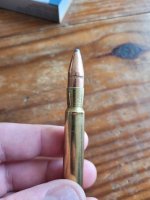
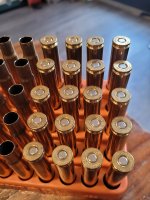
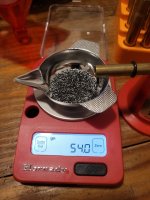
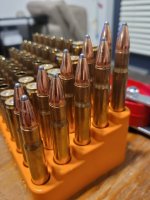
I'm not worried about the bullet staying seated, but do you think it would improve consistency of powder burn by providing a more consistent neck tension?You don’t need to crimp on a single shot rifle.
I get it, and that's what I was originally trying to do... But my chamber has so much freebore that it ain't possible to do so with the bullet I'm using. This is evidently a common issue with the Whelen. So I'm seating at caliber depth and letting them fly in spite of the jump.FWIW I never use the C.O.A.L. for anything. Especially bullet seating. I do all my seating at how far I'm off the lands. That is the measurement that counts.
No indication that crimping improves accuracy, perhaps just the opposite. Crimping is to keep the bullet from moving in the case in certain situations such as the violent feeding in semi-autos, tube feed rifles, and heavy recoiling rifles.I'm not worried about the bullet staying seated, but do you think it would improve consistency of powder burn by providing a more consistent neck tension?
Maybe I am overthinking it... Maybe neck tension is already consistent... Maybe it doesn't even matter that much.
Here is what Lee says about seating depth and crimping:I get it, and that's what I was originally trying to do... But my chamber has so much freebore that it ain't possible to do so with the bullet I'm using. This is evidently a common issue with the Whelen. So I'm seating at caliber depth and letting them fly in spite of the jump.

Reloading Update:
Finally, I loaded 10 rounds with a starting charge (54.0 gr IMR 4064) per my reloading manual... I could have done with less, but I want to shoot a few more rounds.
Yeah, that was my mistake... I edited the post and it became a little unclear when I did... I meant that I could have loaded fewer rounds, not go below published minimums. Thanks for the note.Im not sure what you meant by " could have done with less" hopefully not referring to less powder.
Never go below published minimums.
Despite what one who doesnt understand all the dynamics at play would think makes sense, too little powder can be very dangerous indeed.
Several scenarios due to too little powder come to mind and I have personally due to hard headedness messed up and found out the hard way.
Though I didnt have a catastrophic accident or destroy a gun or myself I did wind up with rounds that would hang fire ( click 1...2...3... BOOM) and also some pretty drastic pressure signs.
If you wind up wanting reduced charge economical plinking loads, or reduced recoil and muzzle blast Hodgdon has some data available using H4895 only that are safe.
The data and formula are available by searching online.
As far as crimping I've read what Lee has to say, but having used the factory crimp die in the past found it to be counterproductive and an unnecessary step that also.adds.extra working of the necks.Low Recoil Loads
www.hodgdonreloading.com
If I misunderstood about " done with less" I still cant reiterate enough about not charging cases below published minimums.
Stay safe and good luck with your range time.
That's some stuff I haven't heard of, but it all makes sense. I'm going to take some time to let that marinate. Thanks for the post.I think uniform, consistent pressure holding the bullet by the case mouth is one of the little things that contribute to accuracy, and these little things add up. But I don't crimp my rounds to achieve this.
Example; I have a number of cases that need sizing and have been shot a few times. I then sort these cases as to manufacturer and sometimes weight. When I run these through the sizer I can feel some are tighter than others and this doesn't work for me.
So I will anneal this batch of cases, done right all the case necks now are the same as far as gripping pressure. When I size them I can feel that it takes similar pressure when I pull the sizing ball back through the case mouth. These are ready to load.
As I load and shoot these cases after a few loadings I can again feel them getting harder to resize and pull the expander back through the case neck. I put these into a container. After awhile I again anneal these cases and basically start over.
Part of my case prep is trim to length. Chamfer case mouth and flash hole from both directions.
At the bottom of the primer pocket is a small radius. This radius can prevent the primer from seating properly or to full depth. I cut this radius out with a primer pocket uniformer tool.
2 other subjects bear mentioning. 1st is to assure that when you size your cases that they are sized true to the centerline of your bore.
2nd I use an inline bullet seater from Hornady. Many manufacturers make one of these but I think they all do basically the same thing.
Understand these things I do as part of my process. Others do things different. It's whatever works for you.
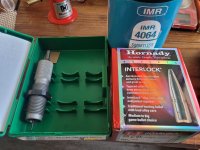

Glad to see your new venture is coming along nicely.Update from Sunday's range trip:
-Fired three groups of progressively hotter loads of 54.5 gr, 55.0 gr, 55.5 gr (max is 59.0 gr)
-No pressure signs
-Accuracy seemed to improve as charge increased, with 55.5 gr being the most accurate
-The 55.5 gr loading shows promise as far as accuracy; I'm saving it in my notes as an option to come back to and tweak.
-I had an improved shooting rest, but shooter error is still the weak point in evaluating load accuracy. I hope to improve this with a new shooting bag and improved technique.
I've loaded more rounds up to 56.0 gr, 56.5 gr, and 57.0 gr. This is getting closer to where I'd like to be as far as velocity, but it may be weekend-after-next before I can get out there to try them out.
Edited to show best group... That one on the right is part of the "shooter error" aspect I was talking about, and I know this is only a preliminary result, but it's the best I've seen out of this rifle so far. Sure does make some big holes...
View attachment 1244083